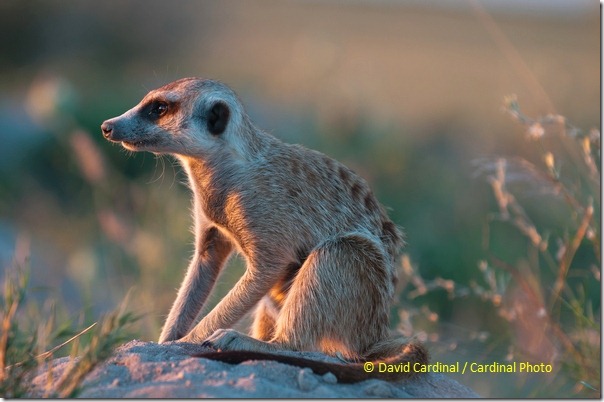- Photo Safaris
- Alaska Bears & Puffins World's best Alaskan Coastal Brown Bear photo experience. Small group size, idyllic location, deluxe lodging, and Puffins!
- Participant Guestbook & Testimonials Candid Feedback from our participants over the years from our photo safaris, tours and workshops. We don't think there is any better way to evaluate a possible trip or workshop than to find out what others thought.
- Custom Photo Tours, Safaris and Personal Instruction Over the years we've found that many of our clients & friends want to participate in one of our trips but the dates we've scheduled just don't work for them or they'd like a customized trip for their family or friends.
- Myanmar (Burma) Photo Tour Myanmar (Burma) Photo Tour December 2017 -- with Angkor Wat option
- Reviews Go hands-on
- Camera Reviews Hands-on with our favorite cameras
- Lens reviews Lenses tested
- Photo Accessories Reviews Reviews of useful Photo and Camera Accessories of interest to our readers
- Useful Tools & Gadgets Handy tools and gadgets we've found useful or essential in our work and want to share with you.
- What's In My Camera Bag The gear David Cardinal shoots with in the field and recommends, including bags and tools, and why
- Articles About photography
- Getting Started Some photography basics
- Travel photography lesson 1: Learning your camera Top skills you should learn before heading off on a trip
- Choosing a Colorspace Picking the right colorspace is essential for a proper workflow. We walk you through your options.
- Understanding Dynamic Range Understanding Dynamic Range
- Landscape Photography Tips from Yosemite Landscape Photography, It's All About Contrast
- Introduction to Shooting Raw Introduction to Raw Files and Raw Conversion by Dave Ryan
- Using Curves by Mike Russell Using Curves
- Copyright Registration Made Easy Copyright Registration Made Easy
- Guide to Image Resizing A Photographers' Guide to Image Resizing
- CCD Cleaning by Moose Peterson CCD Cleaning by Moose Peterson
- Profiling Your Printer Profiling Your Printer
- White Balance by Moose Peterson White Balance -- Are You RGB Savvy by Moose Peterson
- Photo Tips and Techniques Quick tips and pro tricks and techniques to rapidly improve your photography
- News Photo industry and related news and reviews from around the Internet, including from dpreview and CNET
- Getting Started Some photography basics
- Resources On the web
- My Camera Bag--What I Shoot With and Why The photo gear, travel equipment, clothing, bags and accessories that I shoot with and use and why.
- Datacolor Experts Blog Color gurus, including our own David Cardinal
- Amazon Affiliate Purchases made through this link help support our site and cost you absolutely nothing. Give it a try!
- Forums User to user
- Think Tank Photo Bags Intelligently designed photo bags that I love & rely on!
- Rent Lenses & Cameras Borrowlenses does a great job of providing timely services at a great price.
- Travel Insurance With the high cost of trips and possibility of medical issues abroad trip insurance is a must for peace of mind for overseas trips in particular.
- Moose Peterson's Site There isn't much that Moose doesn't know about nature and wildlife photography. You can't learn from anyone better.
- Journeys Unforgettable Africa Journeys Unforgettable -- Awesome African safari organizers. Let them know we sent you!
- Agoda International discounted hotel booking through Agoda
- Cardinal Photo Products on Zazzle A fun selection of great gift products made from a few of our favorite images.
- David Tobie's Gallery Innovative & creative art from the guy who knows more about color than nearly anyone else
- Galleries Our favorite images
Botswana & Zimbabwe Wildlife Photo Safari Trip Report & Images
Botswana & Zimbabwe Wildlife Photo Safari Trip Report & Images
Submitted by David Cardinal on Tue, 07/05/2011 - 07:54
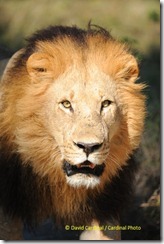 It’s hard to believe that it has been a month since we got back from our photo safari to Africa. As I look at the images it seems like just yesterday. We had another wonderful trip with an excellent group of eight enthusiastic clients and my co-lead Dana Allen. In addition to returning to some of my favorite camps in the Okavango Delta of Botswana and the Kalahari Desert we visited Victoria Falls and Hwange National Park in Zimbabwe. …
It’s hard to believe that it has been a month since we got back from our photo safari to Africa. As I look at the images it seems like just yesterday. We had another wonderful trip with an excellent group of eight enthusiastic clients and my co-lead Dana Allen. In addition to returning to some of my favorite camps in the Okavango Delta of Botswana and the Kalahari Desert we visited Victoria Falls and Hwange National Park in Zimbabwe. …
Victoria Falls: The Smoke That Thunders
In some of the local languages Victoria Falls is aptly called “The Smoke That Thunders.” Seeing the nearly mile wide wall of mist rising from the chasm from the airplane as we flew into Victoria Falls we could understand the smoke part and upon approaching by road the thunder was more than apparent. Our historic hotel was situated just below the falls with a great view of the gorge of the Zambezi River and bridge—favorites for rafters and bungee jumpers alike.
But the highlight was of course the falls themselves. Nearly half a mile wide and five hundred feet high they are over-whelmed with water in May, making them a unique (and wet) experience. Part of the path around the falls was great for getting photos but as we paralleled the falls themselves gear was stashed under ponchos. I’ve visited the falls at several different times of the year and each has a different charm. April, May and June bring high waters and physical drama while the dry season in October and November shows off much more of the cliff formations and geology.
Hwange National Park: Paradise in the Heart of Zimbabwe
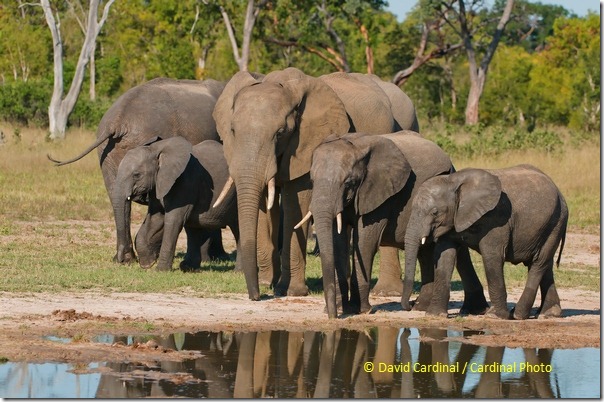
These elephants were only yards from our camp and made for an exciting first afternoon.
Nikon D300S, Nikon 200-400mm Lens at 200mm, f/5.6@1/1000s, ISO 400
Zimbabwe has been in the new a lot over the past few years and most of it hasn’t been positive. But despite the tragedy that exists in many parts of the country it still has some of the world’s best National Parks and one of the highest ratios of protected areas of any country in Africa. Hwange National Park is the crown jewel of their park system, a vast and lightly visited area with large private concessions featuring an incredible variety of game coupled with a secluded setting and unparalleled enthusiastic service from staff and guides alike.
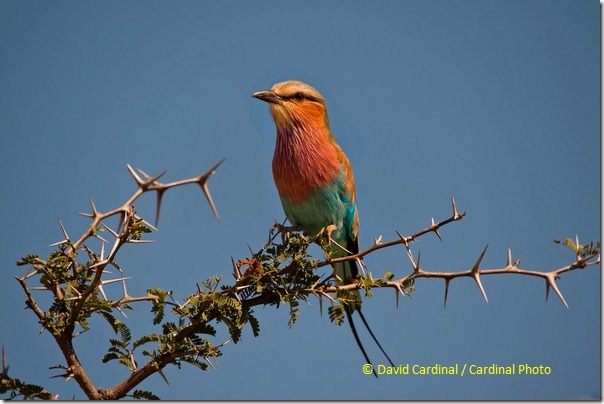
The national bird of Botswana the Lilac-breasted Roller is also abundant in Zimbabwe.
Nikon D700, 200-400mm Lens at 400mm, f5.6@1/1000s, ISO 400.
Our visit was corner-stoned by one of the local lion prides killing a large Cape Buffalo just after we arrived. That provided us with constant activity for the four days we were there. First the lion pride itself and then Hyena, Jackal and Vultures all began to appear to be part of the action. We also had a very dramatic experience with a breeding herd of elephants at the waterhole right in front of the camp. General game viewing was also plentiful with many Giraffe, Cape Buffalo, Zebra and Antelope among other species.
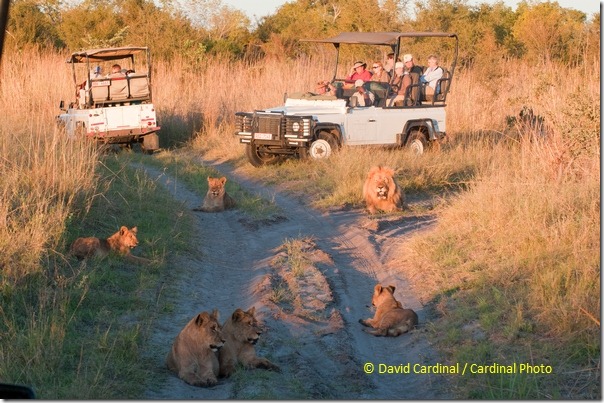
The local lion pride was incredibly cooperative and spent several days with their kill.
Okavango Delta: Africa’s Paradise
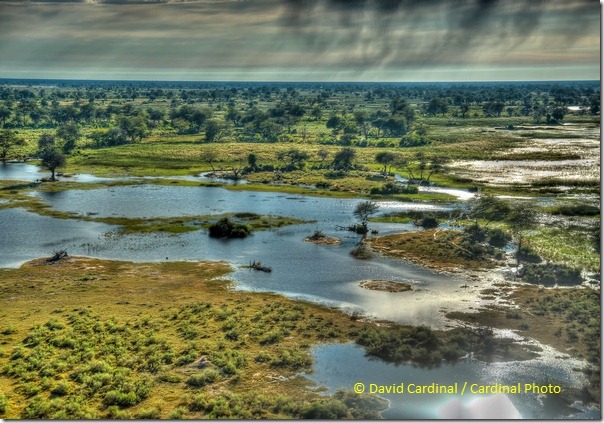
This HDR was made from the helicopter we chartered for a scenic photo flight
It shows the island and water patchwork of the Okavango Delta in the flood season.
The water from Angola’s mountains make this unusual inland delta one of the most fertile areas for wildlife, layering topsoil and plants on top of the deep sands of the Kalahari underneath. The result is an area with unique concentrations of many antelope species which in turn draw large numbers of predators including Lion, Leopard, Cheetah and Wild (Painted) Dogs. The northern Delta is the wettest part while the south is closer to a drier “savanah” habitat, even in the high water levels this year. We stayed at two of my favorite camps in the south and then the north delta, giving us a great overall feel for the variety of landscapes and animals in this popular destination.
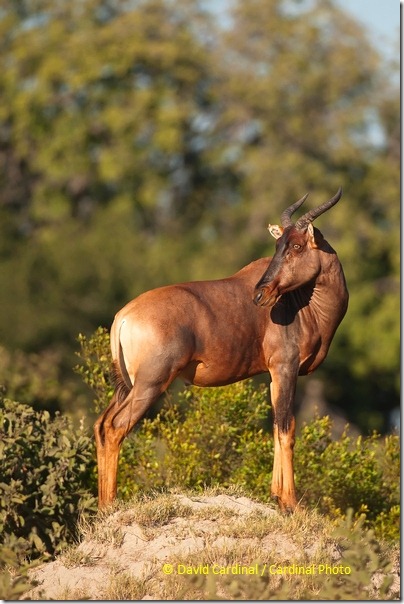
Antelope don’t get too much PR when it comes to African photos,
but like this Tsessebe they are often great subjects.
Our luck with lions continued at both camps. We saw several more prides, often active either hunting or feeding. In addition we had excellent success in finding and spending time with several different leopards—continuing my very lucky streak on that score. The delta didn’t disappoint on antelope either, with a gorgeous herd of uncommon Sable capping many excellent sightings of Impala, Tsessebe and Gnu. Giraffe and Zebra were also plentiful along with always entertaining Baboons and Vervet Monkeys as well as Black-backed Jackals.
We were also fortunate that the very prolific clan of Spotted Hyena we had photographed on previous visits was once again raising a litter of small pups. These made for some of the most amusing moments of the trip as well as for some of the cutest photos. The interactions between several different generations of Hyena were a great study in how they relate to each other. An older female was often left to “babysit” the pups while the adults went off to hunt, but the tiny pups were happy to tease her by popping up from one den entrance just after she had chased them down another. When their mom returned they often had to compete for feeding time with their older siblings who should have been through nursing long before.
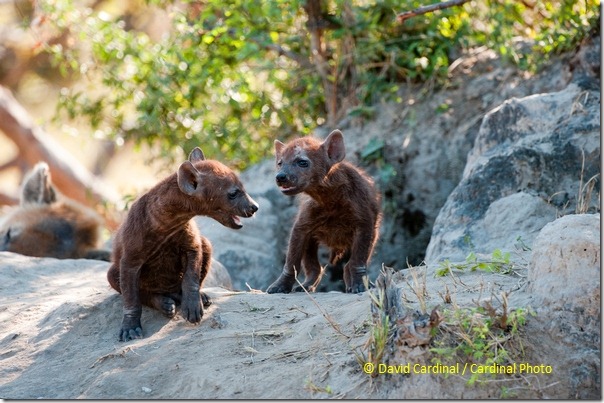
Hyena pups playing outside their den. Mixed shade made for some challenging shooting but the
low light performance and auto white balance of our modern D-SLRs were up to the challenge.
Fun on the Water
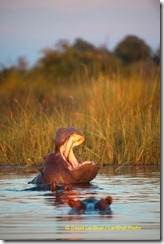 One of the great treats of the northern delta is the ability to get out on the water. Small boat sunset cruises provided a relaxing way to end a long day out on safari and a great opportunity to photograph large Hippos and tiny Kingfishers, while being poled in traditional style “mokoro” dugout canoes made for some amazing macro opportunities with small, colorful Reed Frogs and Water Lilies as well as a different perspective on life in the Delta.
One of the great treats of the northern delta is the ability to get out on the water. Small boat sunset cruises provided a relaxing way to end a long day out on safari and a great opportunity to photograph large Hippos and tiny Kingfishers, while being poled in traditional style “mokoro” dugout canoes made for some amazing macro opportunities with small, colorful Reed Frogs and Water Lilies as well as a different perspective on life in the Delta.
The abundant water in the Delta and elsewhere in southern Africa made it more difficult than usual to get great hippo photos. They simply had a lot more places to live and hide with so many of the vernal pools filled to bursting. In drought years they are often crowded together in the few remaining wet areas.
Life in the Desert with the Bushmen
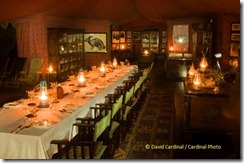 Half of our group was fortunate enough to be able to extend after the main trip and join me for a repeat visit to the depths of the true Kalahari desert, home of the San “bushmen” tribes as well as many unique species such as Meerkats and the largest migration in Southern Africa. No group of humans is more exotic or more fascinating to me than the bushmen who live in the world’s most inhospitable climate—the dry depths of the Kalahari Desert. They are eager to share their knowledge and experiences so as always one of the highlights of our visit was a walk with them through some of their ancestral lands where they showed us how they got water when there was none and many of the different plants they used for food, medicine, hunting poisons and creating fire. Modern civilization continues to have an impact on their communities so it is not clear how long many of their skills and traditions will survive but it was wonderful to be able to visit with these remarkable people.
Half of our group was fortunate enough to be able to extend after the main trip and join me for a repeat visit to the depths of the true Kalahari desert, home of the San “bushmen” tribes as well as many unique species such as Meerkats and the largest migration in Southern Africa. No group of humans is more exotic or more fascinating to me than the bushmen who live in the world’s most inhospitable climate—the dry depths of the Kalahari Desert. They are eager to share their knowledge and experiences so as always one of the highlights of our visit was a walk with them through some of their ancestral lands where they showed us how they got water when there was none and many of the different plants they used for food, medicine, hunting poisons and creating fire. Modern civilization continues to have an impact on their communities so it is not clear how long many of their skills and traditions will survive but it was wonderful to be able to visit with these remarkable people.
As you can see from the photo of historic dining tent at camp we fortunately didn’t have to live like the bushmen while we were there but were instead pampered with great food and service.
“Meerkat Manor”
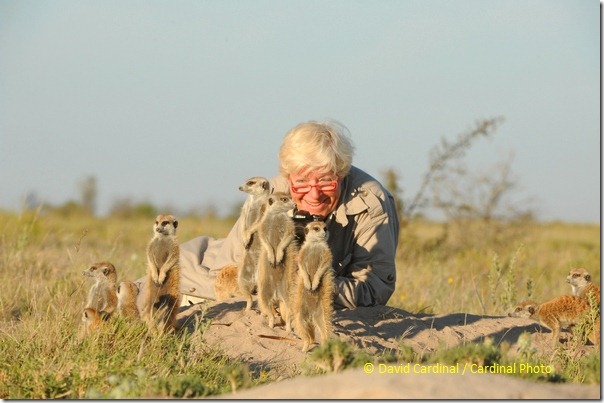
Dee getting some eye to eye close-ups of the Meerkats
We were blessed with great photo opportunities with the only habituated Meerkats in Botswana as well as up close and personal views of the largest migration in southern Africa—a nearly ten mile long line of Zebra heading towards the river 50 miles away as the plains slowly dry up for the cold winter season. Even before the anthropomorphic TV show Meerkat Manor made them famous Meerkats have had a unique fascination because of their “cute” features, family-centric way of life and constant activity. They maraud at high speed from one den location to another, scooping up poisonous scorpions, frogs, lizards, small snakes and nearly anything else they can kill and stuff in their mouths on the way. Their strong claws let them dig ceaselessly at high speed for buried reptiles and amphibians, but when they used them to climb on us they weren’t sharp at all. And yes, they did climb on us. If we were quiet and laid down it was only a matter of time until they decided we were a worthwhile vantage point to host a lookout and hoisted themselves aboard. In the wide variety of experiences available to wildlife photographers it doesn’t get any better than this!
Enjoy the Show
If you’ve enjoyed these photos please take a look at the Africa May 2011 album we’ve posted on our SmugMug Site. Or enjoy this self-running video slideshow we built using the free ProShow/Web service from Photodex and our SmugMug album:
And we’re excited that Talli Koppel, one of our participants, has already created a photo book showcasing her photos and experiences from the trip. You can view or order it on her Blurb site. Our talk on how to easily create effective photo books is always one of the highlights of our trips.
We’ll Be Back!
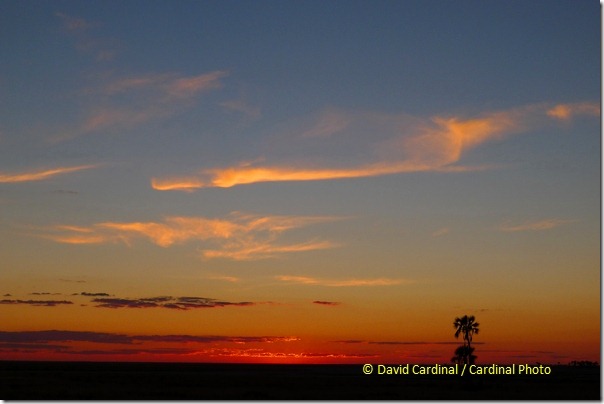
Sunset is a special time on safari, for relaxing and enjoying the scenic opportunities.
As you’ve probably guessed we’ll be headed back to southern Africa. We’re busy planning for a trip in late 2012 and will let everyone know the details on cardinalphoto.com as soon as we have them. You can also make sure that you’re subscribed to our newsletter to get the latest updates. In the meantime we’ve got plenty of other great photo safaris and photo tours planned to Texas, Alaska and Southeast Asia.
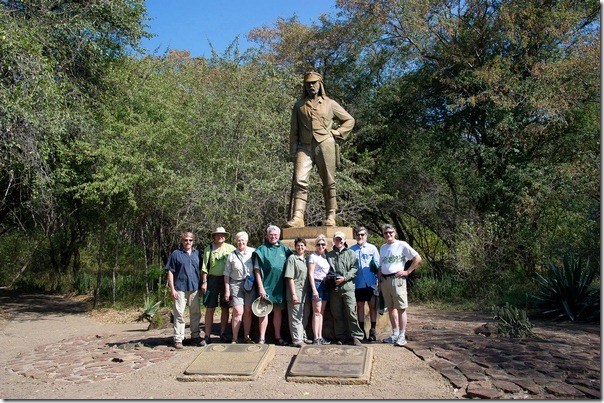
Our group under the statue of David Livingstone at Victoria Falls.
Dana, David, Dee, Bob, Talli, Debbie, Larry, David and Mark. Judy was still on an airplane![]()
- Log in to post comments

